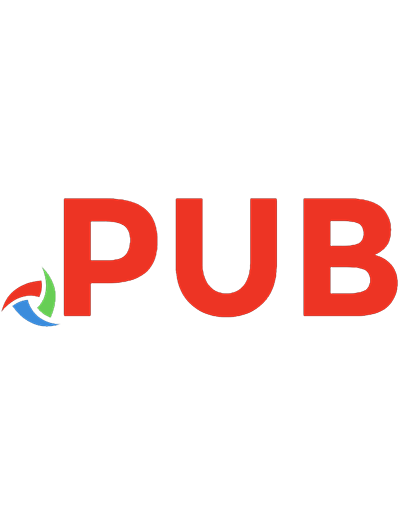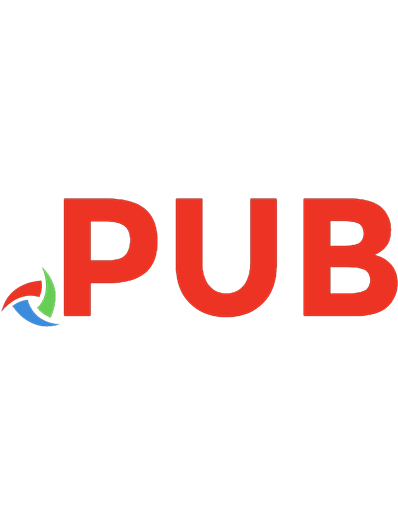100 SOA questions : asked and answered 9780137080205, 0137080204, 9780132119818
100 SOA Questions brings together authoritative answers to the most crucial questions business, technical, and architect
611 114 3MB
English Year 2011
Table of contents :
Content: Preface xviiIntroduction 1 Chapter 1: SOA Basics 5SOA Basics: Q&A 5 1. What Is SOA? 5 2. Is SOA an Architectural Style? 7 3. What Are the Fundamental Constructs (the DNA) of SOA? 9 4. What Is the Difference Between a Web Service and an SOA Service? 14 5. What Makes a Project an SOA Implementation? 15SOA Basics: Key Concepts 16 Chapter 2: Business 19Business: Q&A 21 6. Why Should Business Stakeholders Care About SOA? 21 7. How Should SOA Be Sold to the Business or Business Stakeholder? 25 8. What Is the Return on Investment (ROI) of SOA Adoption? 28 9. How Should the Business Measure the Effectiveness of SOA? 29 10. What Are the Criteria for Selecting a Project for SOA Adoption? 33 11. What Is Flexibility and How Does SOA Deliver on This Promise? 34 12. How Is Reuse Accomplished Using SOA? 36 13. What Should the Business or Business Stakeholders Do Differently Because of SOA? 37 14. Can SOA Be Applied to Business Architecture or Should It Be Used Solely for IT? 40 15. What Are the Common Pitfalls from a Business Vantage Point in Adopting SOA? 42Business: Key Concepts 43 Chapter 3: Organization 45Organization: Q&A 46 16. How Does Business / IT Alignment Change Because of SOA? 46 17. Which Joint Business / IT Processes Change Because of SOA? 49 18. What Organization Structures Should Be Established for SOA? 50 19. What Is the Role of Organizational Change Management to SOA? 56 20. How Can Organizational Barriers to SOA Success Be Removed? 58 21. How Should Organizations Address Funding for Services? 59 22. How Should Organizations Address Prioritization for Shared Services? 63 23. What Are Service Owners? 64 24. What is the Value of Classifying Services? 65 25. Who Owns Service Reuse? 66 26. What Are the Common Organizational Pitfalls When Adopting SOA? 67Organization: Key Concepts 68 Chapter 4: Governance 71Governance: Q&A 72 27. What Is SOA Governance? 72 28. How Does an Organization Get Started with SOA Governance? 75 29. What Is the Role of Change Management? 79 30. Does Implementation of SOA Tools and Infrastructure Equate to SOA Governance? 81 31. Should Service Development Be Centralized in Service Centers? 83 32. Does SOA Require Centers of Excellence, Architecture Boards, or Design Boards? 84 33. Why Do Organizations Need to Focus on SOA Governance When There Is an Effective Enterprise Architecture Activity? 87 34. Is SOA Governance Required for SOA Projects to Be Successful? 89 35. How Can You Measure Whether SOA Governance Is Effective? 90 36. What Is the Difference Between Design-Time and Runtime Governance? 91 37. What Are Common Pitfalls of SOA Governance? 92Governance: Key Concepts 93 Chapter 5: Methods 95Methods: Q&A 96 38. Should an Organization Continue to Use Agile or Object Development Methods for SOA Projects? 96 39. What Changes in System Development Result from SOA? 98 40. Does SOA Require Service Modeling? 101 41. How Should Services Be Identified or Specified to Maximize Reuse? 103 42. How Should the Granularity of a Service Be Determined? 106 43. Should SOA Be Used Only for Custom Development Projects? 107 44. Are Any New Development Roles Introduced by SOA Methods? 109 45. Does SOA Change Testing Methods? 110 46. How Do SOA Methods Accelerate Application Development? 112 47. How Do SOA Methods Reduce the Lifetime Costs for Applications? 114 48. What Are the Common Pitfalls in Adopting SOA Methods? 115 Methods: Key Concepts 116 Chapter 6: Applications 119Applications: Q&A 121 49. Do Applications Still Exist with SOA? 121 50. Do Applications Get Replaced with Composite Services/Applications? 121 51. Is a Certain Type of Business Problem Best Suited for SOA Adoption? 123 52. Is a Certain Type of IT Problem Best Suited for SOA Adoption? 127 53. What Changes with Application Development When SOA Is Introduced? 128 54. What Is the Relationship of Business Process Management to an Application? 133 55. How Does SOA Make Applications or a Portfolio of Applications More Flexible? 137 56. Should an Application Portfolio Be Managed Differently Because of SOA Adoption? 139 57. Can Existing Systems or Legacy Applications Be Leveraged When Adopting SOA? 140 58. How Are Services Built That Will Deploy in a Cloud? 142 59. Does It Make Sense to Adopt SOA for One Application Versus the Enterprise? 143 60. What Are Common Pitfalls for Application Teams Adopting SOA? 144Applications: Key Concepts 145 Chapter 7: Architecture 147Architecture: Q&A 149 61. How Does Architecture Change as a Result of SOA Adoption? 149 62. How Does SOA Differ from Earlier Approaches, such as DCE or CORBA? 156 63. How Do Web Services and SOA Differ? 157 64. Is SOA Too Complex and Enterprise-Level Only? 158 65. How Do Interfaces and Contracts Differ? 160 66. Should Applications Choose WSDL or REST? 162 67. What Is the Relationship Between Enterprise Architecture and SOA? 165 68. How Do EAI, SOA, and SOI Differ from One Another? 167 69. What Is the Role of Standards in SOA Implementations? 168 70. How Should Standards Be Applied to Enable Successful SOA Implementations? 169 71. What Are the Common Pitfalls When Adapting an IT Architecture for SOA? 170Architecture: Key Concepts 172 Chapter 8: Information 173Information: Q&A 174 72. What Is the Relationship Between Information Architecture and SOA? 174 73. What Are Information Services? 175 74. How Are Information Services Classified? 176 75. Do Information Services Differ from Other Services? 178 76. How Should Information Services Be Identified? 180 77. When Should Information Services Perform Create, Read, Update, and Delete (CRUD) Operations? 181 78. Are Enterprise Information Models Required for Effective SOA Implementations? 182 79. What Is a Canonical Message Model? 184 80. How Should a Canonical Message Model Be Created? 186 81. Can SOA Improve Data Quality? 187 82. What Are the Common Pitfalls with Information Architecture and SOA? 188Information: Key Concepts 189 Chapter 9: Infrastructure 191Infrastructure: Q&A 193 83. What Are the Building Blocks of an SOA Infrastructure? 193 84. What is an Enterprise Service Bus? 199 85. What Are Best Practices for Creating the SOA Infrastructure? 200 86. What Makes an Enterprise Service Bus Different from Integration Technology? 201 87. How Does an ESB and Registry Relate? 203 88. How Does an SOA Infrastructure Support Events? 204 89. How Does the SOA infrastructure Evolve to Realize the Increased Loose Coupling? 205 90. How Does SOA Infrastructure Support Policy Management? 209 91. How Is Management of the Infrastructure Affected by SOA? 212 92. What Is the Role of Cloud Computing in an SOA Infrastructure? 213 93. What Are the Common Pitfalls in Creating an SOA Infrastructure? 214Infrastructure: Key Concepts 217 Chapter 10: The Future of SOA 219Future: Q&A 220 94. Is SOA Dead, Stagnant, or Moving Forward in its Adoption? 220 95. What Is the Future Trajectory of SOA? 221 96. What Are Context-Aware Services? 224 97. What Role Does SOA Play in Embedded or Real-Time Systems? 225 98. What Is the Relationship Between Event-Driven Architecture and SOA? 225 99. How Does the Slow Maturation of Standards Affect the Future of SOA? 227 100. Do WOA and Web 2.0 Affect the Future of SOA? 228Future: Key Concepts 229 Index 231




![Grammar and Usage: Your Questions Answered: A New and Updated Version of 'English Grammar: Your Questions Answered' [2 ed.]](https://dokumen.pub/img/200x200/grammar-and-usage-your-questions-answered-a-new-and-updated-version-of-english-grammar-your-questions-answered-2nbsped.jpg)





